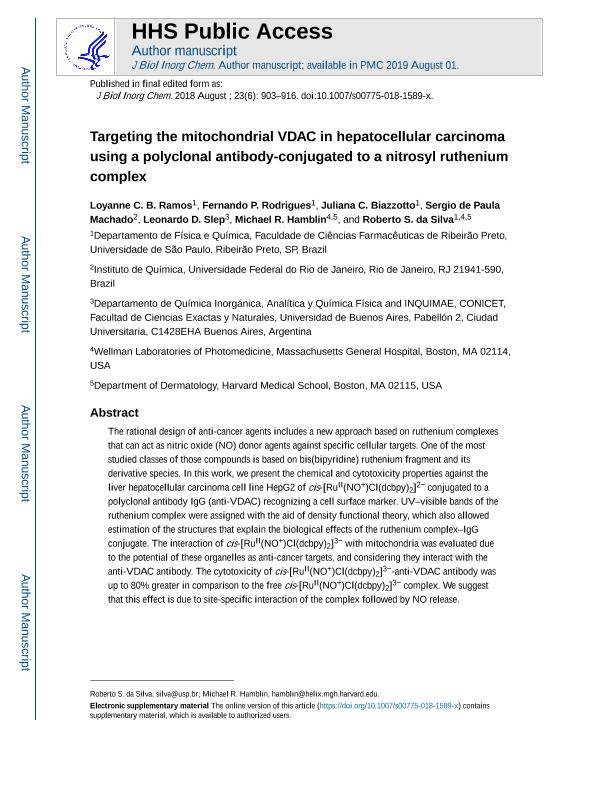Artículo
Targeting the mitochondrial VDAC in hepatocellular carcinoma using a polyclonal antibody-conjugated to a nitrosyl ruthenium complex
Ramos, Loyanne C. B.; Rodrigues, Fernando P.; Biazzotto, Juliana C.; de Paula Machado, Sergio; Slep, Leonardo Daniel ; Hamblin, Michael R.; da Silva, Roberto S.
; Hamblin, Michael R.; da Silva, Roberto S.
 ; Hamblin, Michael R.; da Silva, Roberto S.
; Hamblin, Michael R.; da Silva, Roberto S.
Fecha de publicación:
08/2018
Editorial:
Springer
Revista:
Journal of Biological Inorganic Chemistry
ISSN:
0949-8257
Idioma:
Inglés
Tipo de recurso:
Artículo publicado
Clasificación temática:
Resumen
The rational design of anti-cancer agents includes a new approach based on ruthenium complexes that can act as nitric oxide (NO) donor agents against specific cellular targets. One of the most studied classes of those compounds is based on bis(bipyridine) ruthenium fragment and its derivative species. In this work, we present the chemical and cytotoxicity properties against the liver hepatocellular carcinoma cell line HepG2 of cis-[RuII(NO+)Cl(dcbpy)2]2− conjugated to a polyclonal antibody IgG (anti-VDAC) recognizing a cell surface marker. UV–visible bands of the ruthenium complex were assigned with the aid of density functional theory, which also allowed estimation of the structures that explain the biological effects of the ruthenium complex–IgG conjugate. The interaction of cis-[RuII(NO+)Cl(dcbpy)2]3− with mitochondria was evaluated due to the potential of these organelles as anti-cancer targets, and considering they interact with the anti-VDAC antibody. The cytotoxicity of cis-[RuII(NO+)Cl(dcbpy)2]3−-anti-VDAC antibody was up to 80% greater in comparison to the free cis-[RuII(NO+)Cl(dcbpy)2]3− complex. We suggest that this effect is due to site-specific interaction of the complex followed by NO release.
Archivos asociados
Licencia
Identificadores
Colecciones
Articulos(INQUIMAE)
Articulos de INST.D/QUIM FIS D/L MATERIALES MEDIOAMB Y ENERGIA
Articulos de INST.D/QUIM FIS D/L MATERIALES MEDIOAMB Y ENERGIA
Citación
Ramos, Loyanne C. B.; Rodrigues, Fernando P.; Biazzotto, Juliana C.; de Paula Machado, Sergio; Slep, Leonardo Daniel; et al.; Targeting the mitochondrial VDAC in hepatocellular carcinoma using a polyclonal antibody-conjugated to a nitrosyl ruthenium complex; Springer; Journal of Biological Inorganic Chemistry; 23; 6; 8-2018; 903-916
Compartir
Altmétricas



